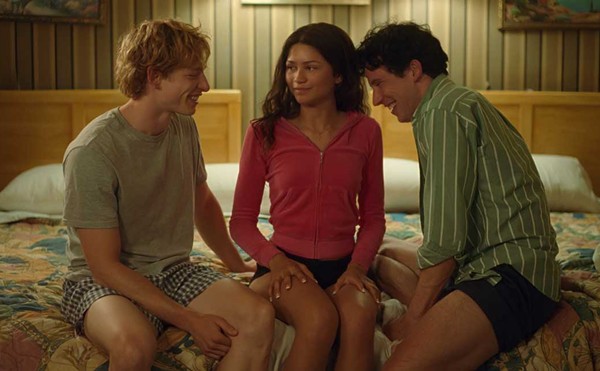After seeing Monica, the new film by Italian writer-director Andrea Pallaoro, I’m sure opinions will be divided. Shot in a narrow aspect ratio and composed almost entirely of static shots, Monica could be dismissed as a chilly exercise in rigid formalism. Other (harsher) critics will label its heavy subject matter and infrequent bursts of levity an endurance test of unrelenting miserabilism. Allow me to quell the storm by simply stating: No film this quietly potent or gently restrained should ever elicit such strong adverse reactions.
A passion project of sorts for both star Trace Lysette and filmmaker Pallaoro, Monica serves as the second installment in an intended trilogy of female-led films from Pallaoro. And like any great middle act, this delicate and heartrending work makes key improvements over its spiritual predecessor, Hannah (2017).
The most prominent of these? Pallaoro’s firmer grasp of what Paul Schrader labels “slow cinema”: works in the vein of Chantal Akerman’s Jeanne Dielman, 23 quai du Commerce, 1080 Bruxelles (1975), Béla Tarr’s Sátántangó (1994), or Abbas Kiarostami’s Taste of Cherry (1997) that utilize sparse camera movements, plain dialogue, long takes and minimal cuts to better immerse the viewer (and put us to work parsing out so-called essential elements like exposition or plot). A dying art, according to Schrader, but one that is alive and well here.
We meet our title character Monica (Lysette) in a tanning bed. Still and expressionless, she handles the heat like a pro — an early indication of how she’ll navigate the intense new reality that’s soon to come. A phone call from a stranger brings news no one wants to hear, especially Monica: Her estranged mother Eugenia (Patricia Clarkson) is terminally ill, and there’s not much time left. She’s rapidly dwindling, and Monica needs to get there fast if she hopes to see her before it’s too late.
Unquestionably, this story sounds familiar to you — you’ve no doubt seen it dozens of times. However, upon her arrival back home, we discover Monica is taking a new approach to this conventional setup.
As it turns out, Monica and her mom haven’t seen (let alone spoken to) one another in more than 10 years. It’s been so long, in fact, that her mother seemingly doesn’t even recognize her own daughter. Time isn’t the only factor at fault, though. Monica never informed Eugenia she was transitioning before Eugenia’s memory began to fade.
Through alternating glimpses of Monica in quiet solitude and engaging in honest conversations with brother Paul (Joshua Close), sister-in-law Laura (Emily Browning), and even Eugenia herself (who believes Monica to be merely a friend helping out in her time of need), we can begin to piece together who this fractured family was, is, and — blame ignorance, blame illness, blame stubbornness, blame death — will forever be robbed the chance to become.
For Monica and Eugenia, the key word is dignity above all else. It was dignity that kept daughter alienated from mother for all their years apart, and now, in the mother’s old age and worsening state, it’s dignity that is allowing the pair to see eye to eye for perhaps the first time in their lives. Monica was hurt badly by her mother, and there’s no hiding that pain — its shadow is present in her every action, from the way she cares for Eugenia to the way she carries herself around her childhood abode. Returning to help in her mother’s time of need doesn’t make her initial decision to leave any less meaningful or right.
Likewise, Eugenia makes no mention of her daughter, even as the end nears. Does she know Monica’s true identity? Does she recognize the face so close to hers, gazing into her eyes with sympathy and compassion despite all that’s come before? If she does, she’s not saying a word about it. Lysette and Clarkson are naturally, profoundly raw in these roles, and it’s never more apparent than in the quiet moments where dignity takes precedence over all that could be said.
Pallaoro’s script — co-written with Orlando Tirado, who also shares a co-writing credit on all other Pallaoro works thus far — stands out to me as fascinatingly taciturn. The questions that arise throughout the film (both in the audience’s mind and the character’s lives) are not ignored, but rather … beaten around the bush. Pallaoro intentionally keeps the big things left unsaid, relegating all hints and clues to quiet conversations just off-screen, muddled arguments in the background, or one-sided phone calls that withhold key information from the viewer. That’s not to say we’re left in the dark, however: We rely on context to parse what’s really going on, making for a surprisingly involved but nevertheless rewarding viewing experience — straight out of the slow cinema textbook.
The camera is no less reticent. Cinematographer Katelin Arizmendi stays calm and unhurried, shooting in gorgeous 35mm and maintaining a tight, almost 1:1 aspect ratio. It makes for a much-needed respite from the aggressively digital shaky-cam style that has all but taken over the subgenre of Intimate Indie Character Study. There’s a different (read: worse) version of this film littered with teary, Academy-aspiring monologues and flashy, in-your-face camerawork. Thankfully, Monica has too much respect for its characters and its audience to be so trite. Pallaoro’s film is something much more beautiful, much more extraordinary than the banality I’ve come to expect from the contemporary arthouse portrait.
Film Details
Subscribe to Metro Times newsletters.
Follow us: Google News | NewsBreak | Reddit | Instagram | Facebook | Twitter







